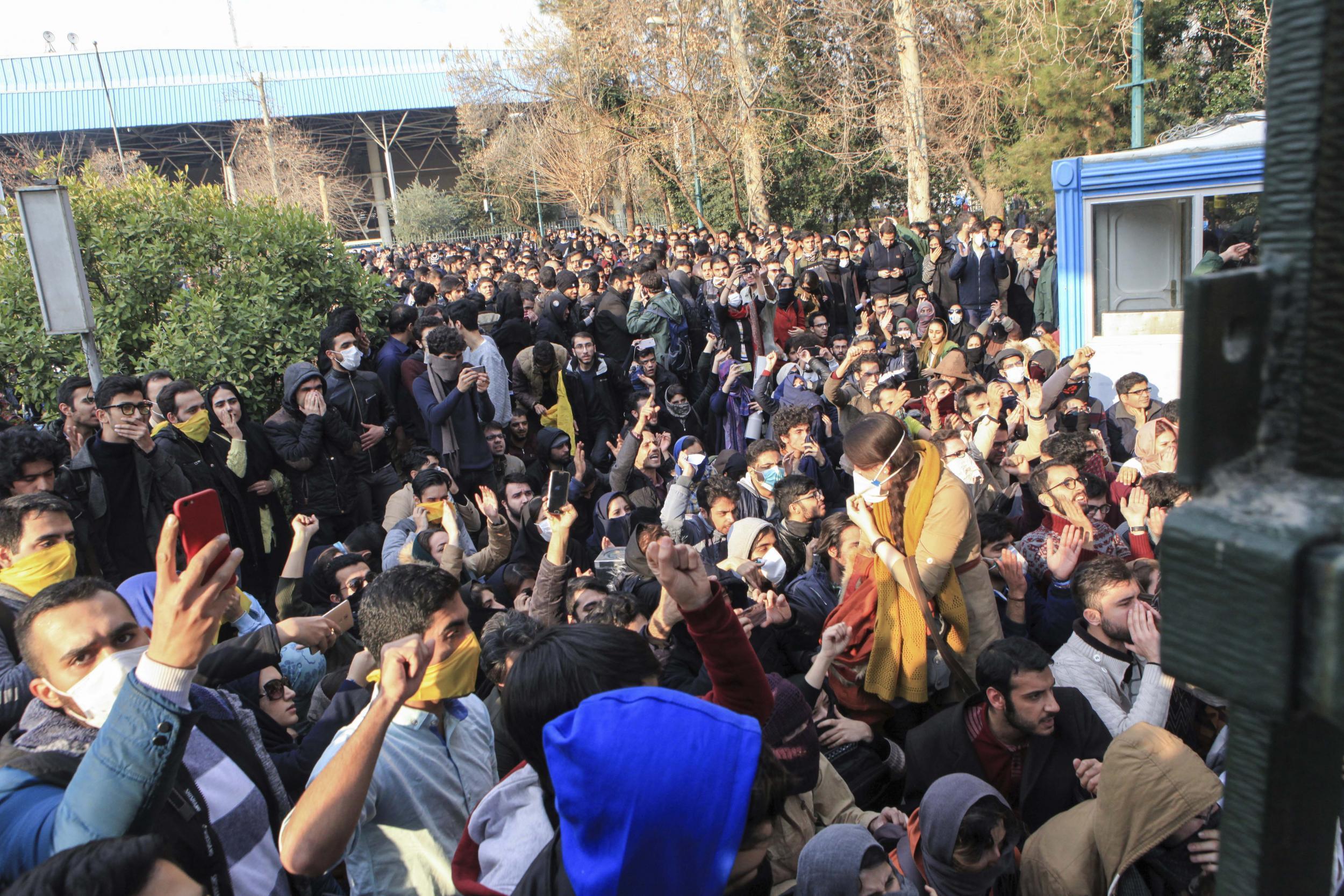There’s no easy way for President Rouhani to end the Iran protests
There has been some economic dividend from the nuclear agreements with world powers such as Iran being able to sell oil in the global market, but others have been stymied by the US failing to lift a range of sanctions


Your support helps us to tell the story
From reproductive rights to climate change to Big Tech, The Independent is on the ground when the story is developing. Whether it's investigating the financials of Elon Musk's pro-Trump PAC or producing our latest documentary, 'The A Word', which shines a light on the American women fighting for reproductive rights, we know how important it is to parse out the facts from the messaging.
At such a critical moment in US history, we need reporters on the ground. Your donation allows us to keep sending journalists to speak to both sides of the story.
The Independent is trusted by Americans across the entire political spectrum. And unlike many other quality news outlets, we choose not to lock Americans out of our reporting and analysis with paywalls. We believe quality journalism should be available to everyone, paid for by those who can afford it.
Your support makes all the difference.Among the latest to die in the rising violence in Iran were an 11-year-old boy, a 20-year-old man and the first member of the security forces, from the Revolutionary Guard. Hunting rifles, commonly available in rural areas, were said to have been used in the shootings. The killings, if accounts of them are true, are a significant development in an increasingly volatile and incendiary situation.
The hardliners can use these deaths as evidence that extremists or foreign agents are behind the protests and demand a severe crackdown. Some of those who have been taking part in the demonstrations are themselves concerned that agent provocateurs are at work trying to sabotage their legitimate protests against economic hardship and corruption.
The pace and scale at which events had developed, spreading so swiftly across the country, has caused widespread surprise, confusion and, inevitably, conspiracy theories of “hidden hands” at play. Donald Trump’s constant tweets encouraging an uprising have added to the combustible mixture, damaging rather than aiding the cause of the genuine protestors.
The rallies began in Mashhad last Thursday. The city is a centre of Shia theocracy and also the home of Ebrahim Raisi, the hardline candidate who lost the presidential election to the reformist Hassan Rouhani, and Raisi’s father-in-law, Ayatollah Ahmad Alamolhoda, a senior figure among the conservative clergy. The slogans were anti-Rouhani and his economic and social policies, with accusations raised during the election campaign.
The protests then, as we saw, spread rapidly through the country, with the attacks not just against rising prices and unemployment, but also against corruption, the clergy, foreign policy and, to some astonishment, against the supreme leader, Grand Ayatollah Ali Khamenei. There have even been, albeit on just a few occasions, chants in the memory of the late Shah overthrown in the Iranian Revolution.
Along with the demonstrations has come increased violence. During the first days videos appeared of a Basij militiaman being disarmed and having his trousers removed amid laughter before being allowed to go in Kermanshah; policemen had their batons taken away and asked to leave.
There are now attacks on police stations and Basij bases. By this morning the death toll stood at 21, nine of them overnight. Ali Asghar Nasserbakht, the deputy governor of Tehran, stated that, in the capital alone, 200 people were arrested on Saturday, 150 on Sunday and 100 on Monday. The government has banned the social media sites, Instagram and Telegram, but the marches have continued.
Hamid, a 23-year-old student I had met in Tehran earlier this year, has taken part in demonstrations for three days: but he was adamant that there has been little coordination for them in different locations and no central planning.
“What happened at Mashhad wasn’t that surprising, but then it seemed to be happening everywhere and people joined in, it really was spontaneous,” he insisted. “If there are any plots to overthrow the government, we are certainly not part of it. Different people are protesting about different things. For the students it is about no jobs after studying so hard. Some workers are on poor pay or say they haven’t been paid and everyone is getting fed up prices which just keep rising. Some Principlists [Conservatives] are protesting because they lost the election and don’t like Rouhani and the liberals.”
Hamid also offered that he had come across things he found disturbing. “On Saturday a few men turned up who were masked and were quite aggressive, we didn’t know who they were. We have also heard people shouting: “Reza Shah, bless your soul”. What was all that about? Most of us don’t remember anything about the Shah.”
His friend Bijan, 28, a qualified hydraulic engineer without a full-time job for two years, added: “There is the possibility that people may be trying to exploit the situation. We don’t want anyone to exploit rightful protests, the Principlists or outside people like the Saudis or the Americans. We don’t want President Rouhani to go – I voted for him – but he needs to make the reforms that were promised.”
The target of the protests in the holy cities of Mashhad and Qom has also, to some extent, shifted from Rouhani to the conservative clergy. This is unusual, but not entirely surprising. In three visits to Qom, the Shia Vatican, in the past 18 months, I have been struck by the increasing number of young people, including theology students, who had come forward to stress the need for change and reform, reflecting similar views as those of people of their age in other cities.
Grand Ayatollah Khamenei had sought to keep himself above the troubles. It is a sign of concern among the senior clergy that he has now publicly intervened. “The enemies of Iran are deploying every means at their disposal including money, arms and political and intelligence support to coordinate making trouble for the Islamic establishment,” he said. “The enemy is always looking for an opportunity and any service to infiltrate and strike the Iranian nation.”
Officials in Tehran point to the repeated threats made by the Saudi government against Iran. These have grown in volume and become more emboldened since Donald Trump got to the White House. The words of the seemingly all-powerful Saudi Crown Prince Mohammed bin Salman, “we will work so that the battle for then is in Iran”, are often quoted. An Isis attack in Tehran last June was blamed by the Revolutionary Guard on Riyadh.
Hassan Rouhani’s government is at a hard place. There has been some economic dividend from the nuclear agreements with world powers such as Iran being able to sell oil in the global market, but others have been stymied by the US failing to lift a range of sanctions. Trump’s refusal to back the nuclear deal has created further uncertainty for the country’s international trade.
Unemployment remains high at 12.4 per cent, up 1.4 per cent in the previous 12 months. There has been a steady rise in food prices with a drastic hike in the cost of poultry, by up to 40 per cent, one of the triggers for the protests. The government blames the shortage and price rise due to the necessity of a cull to prevent an outbreak of avian flu.
There has been criticism of there being no women in senior positions in his cabinet and the slow pace of reform. The President has complained that hardliners and conservative clerics are blocking liberalisation moves by his government.
So far President Rouhani has defended the right to protest while warning that lawlessness and destruction will not be tolerated; police, rather than Revolutionary Guards, have been on the streets. But it remains uncertain what will happen if the violence continues to escalate and the hardliners press for action.
People like Dariush Ghorbani, a businessman from Isfahan who voted for the reformists in the parliamentary and presidential elections, are beginning to feel a sense of foreboding. “We need reforms and we need them fast, that must be clear now,” he said. “If President Rouhani is being blocked in this, then he must remove the blockage, the people will support him in this. But there are worries about the violence, the deaths. There are unexplained ones, like these shootings. Who is carrying these out?
“We hope the situation will get back under control, the violence and reforms will be a good result from this. We Iranians will solve problems ourselves. We don’t want foreign interference. I really wish Donald Trump will stop his tweets, don’t they ever stop?”
But the one certainty in the uncertainty surrounding Iran at the moment, one can safely say, is that there is no chance at all of Donald Trump’s tweets ending anytime soon, whatever harm they do.
Join our commenting forum
Join thought-provoking conversations, follow other Independent readers and see their replies
Comments